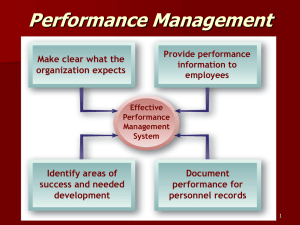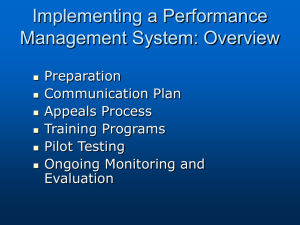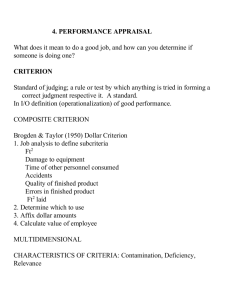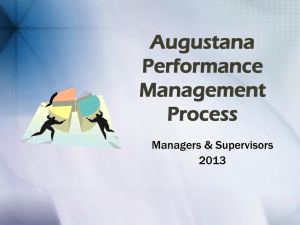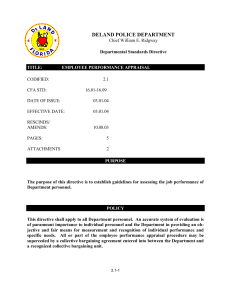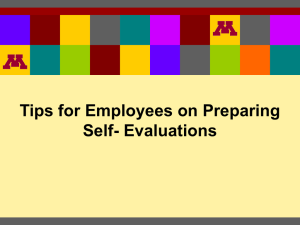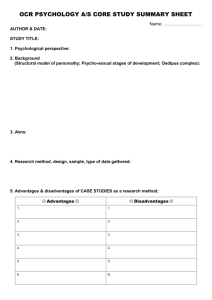Performance Appraisal - An Unavoidable Human Resource
advertisement
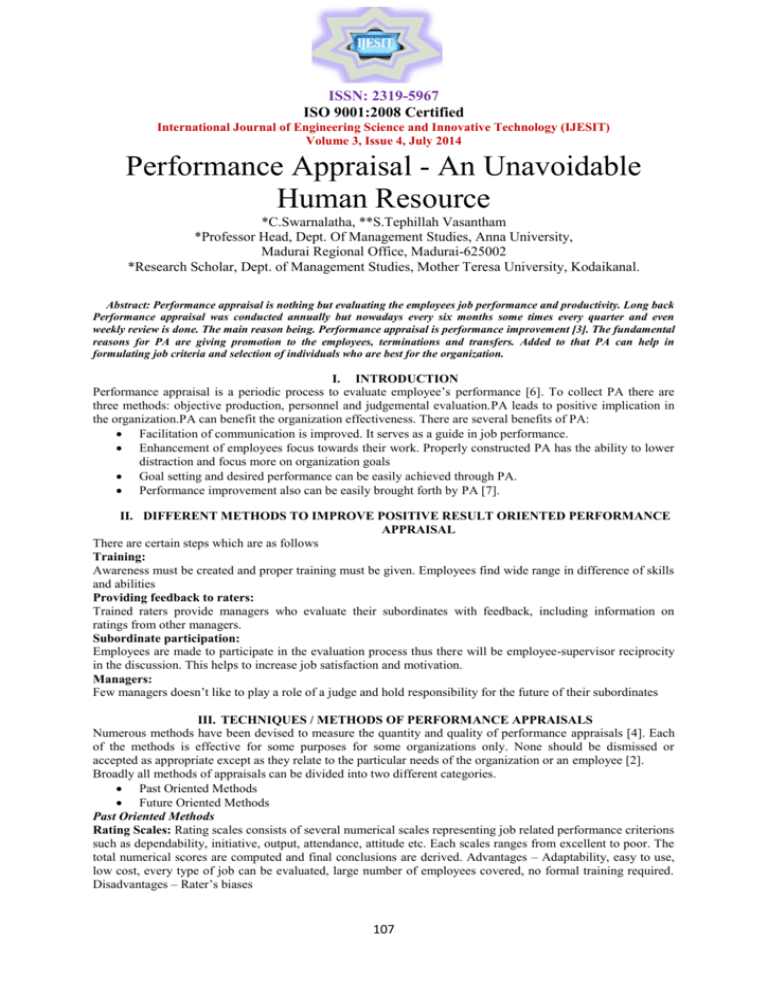
ISSN: 2319-5967 ISO 9001:2008 Certified International Journal of Engineering Science and Innovative Technology (IJESIT) Volume 3, Issue 4, July 2014 Performance Appraisal - An Unavoidable Human Resource *C.Swarnalatha, **S.Tephillah Vasantham *Professor Head, Dept. Of Management Studies, Anna University, Madurai Regional Office, Madurai-625002 *Research Scholar, Dept. of Management Studies, Mother Teresa University, Kodaikanal. Abstract: Performance appraisal is nothing but evaluating the employees job performance and productivity. Long back Performance appraisal was conducted annually but nowadays every six months some times every quarter and even weekly review is done. The main reason being. Performance appraisal is performance improvement [3]. The fundamental reasons for PA are giving promotion to the employees, terminations and transfers. Added to that PA can help in formulating job criteria and selection of individuals who are best for the organization. I. INTRODUCTION Performance appraisal is a periodic process to evaluate employee’s performance [6]. To collect PA there are three methods: objective production, personnel and judgemental evaluation.PA leads to positive implication in the organization.PA can benefit the organization effectiveness. There are several benefits of PA: Facilitation of communication is improved. It serves as a guide in job performance. Enhancement of employees focus towards their work. Properly constructed PA has the ability to lower distraction and focus more on organization goals Goal setting and desired performance can be easily achieved through PA. Performance improvement also can be easily brought forth by PA [7]. II. DIFFERENT METHODS TO IMPROVE POSITIVE RESULT ORIENTED PERFORMANCE APPRAISAL There are certain steps which are as follows Training: Awareness must be created and proper training must be given. Employees find wide range in difference of skills and abilities Providing feedback to raters: Trained raters provide managers who evaluate their subordinates with feedback, including information on ratings from other managers. Subordinate participation: Employees are made to participate in the evaluation process thus there will be employee-supervisor reciprocity in the discussion. This helps to increase job satisfaction and motivation. Managers: Few managers doesn’t like to play a role of a judge and hold responsibility for the future of their subordinates III. TECHNIQUES / METHODS OF PERFORMANCE APPRAISALS Numerous methods have been devised to measure the quantity and quality of performance appraisals [4]. Each of the methods is effective for some purposes for some organizations only. None should be dismissed or accepted as appropriate except as they relate to the particular needs of the organization or an employee [2]. Broadly all methods of appraisals can be divided into two different categories. Past Oriented Methods Future Oriented Methods Past Oriented Methods Rating Scales: Rating scales consists of several numerical scales representing job related performance criterions such as dependability, initiative, output, attendance, attitude etc. Each scales ranges from excellent to poor. The total numerical scores are computed and final conclusions are derived. Advantages – Adaptability, easy to use, low cost, every type of job can be evaluated, large number of employees covered, no formal training required. Disadvantages – Rater’s biases 107 ISSN: 2319-5967 ISO 9001:2008 Certified International Journal of Engineering Science and Innovative Technology (IJESIT) Volume 3, Issue 4, July 2014 Checklist: Under this method, checklist of statements of traits of employee in the form of Yes or No based questions is prepared. Here the rater only does the reporting or checking and HR department does the actual evaluation. Advantages – economy, ease of administration, limited training required, standardization. Disadvantages – Raters biases, use of improper weighs by HR, does not allow rater to give relative ratings Forced Choice Method: The series of statements arranged in the blocks of two or more are given and the rater indicates which statement is true or false. The rater is forced to make a choice. HR department does actual assessment. Advantages – Absence of personal biases because of forced choice. Disadvantages – Statements may be wrongly framed. Forced Distribution Method: here employees are clustered around a high point on a rating scale. Rater is compelled to distribute the employees on all points on the scale. It is assumed that the performance is conformed to normal distribution. Advantages – Eliminates Disadvantages – Assumption of normal distribution, unrealistic, errors of central tendency. Critical Incidents Method: The approach is focused on certain critical behaviors of employee that makes all the difference in the performance. Supervisors as and when they occur record such incidents. Advantages – Evaluations are based on actual job behaviors, ratings are supported by descriptions, feedback is easy, reduces recency biases, chances of subordinate improvement are high. Disadvantages – Negative incidents can be prioritized, forgetting incidents, overly close supervision; feedback may be too much and may appear to be punishment. Behaviorally Anchored Rating Scales: statements of effective and ineffective behaviors determine the points. They are said to be behaviorally anchored. The rater is supposed to say, which behavior describes the employee performance. Advantages – helps overcome rating errors. Disadvantages – Suffers from distortions inherent in most rating techniques. Field Review Method: This is an appraisal done by someone outside employees’ own department usually from corporate or HR department. Advantages – Useful for managerial level promotions, when comparable information is needed, Disadvantages – Outsider is generally not familiar with employees work environment, Observation of actual behaviors not possible. Performance Tests & Observations: This is based on the test of knowledge or skills. The tests may be written or an actual presentation of skills. Tests must be reliable and validated to be useful. Advantage – Tests may be apt to measure potential more than actual performance. Disadvantages – Tests may suffer if costs of test development or administration are high. Confidential Records: Mostly used by government departments, however its application in industry is not ruled out. Here the report is given in the form of Annual Confidentiality Report (ACR) and may record ratings with respect to following items; attendance, self-expression, team work, leadership, initiative, technical ability, reasoning ability, originality and resourcefulness etc. The system is highly secretive and confidential. Feedback to the assesse is given only in case of an adverse entry. Disadvantage is that it is highly subjective and ratings can be manipulated because the evaluations are linked to HR actions like promotions etc. Essay Method: In this method the rater writes down the employee description in detail within a number of broad categories like, overall impression of performance, promote ability of employee, existing capabilities and qualifications of performing jobs, strengths and weaknesses and training needs of the employee. Advantage – It is extremely useful in filing information gaps about the employees that often occur in a better-structured checklist. Disadvantages – It its highly dependent upon the writing skills of rater and most of them are not good writers. They may get confused success depends on the memory power of raters. Cost Accounting Method: Here performance is evaluated from the monetary returns yields to his or her organization. Cost to keep employee, and benefit the organization derives is ascertained. Hence it is more dependent upon cost and benefit analysis. 108 ISSN: 2319-5967 ISO 9001:2008 Certified International Journal of Engineering Science and Innovative Technology (IJESIT) Volume 3, Issue 4, July 2014 Comparative Evaluation Method (Ranking & Paired Comparisons): These are collection of different methods that compare performance with that of other co-workers. The usual techniques used may be ranking methods and paired comparison method. Ranking Methods: Superior ranks his worker based on merit, from best to worst. However how best and why best are not elaborated in this method. It is easy to administer and explanation. Paired Comparison Methods: In this method each employee is rated with another employee in the form of pairs. The number of comparisons may be calculated with the help of a formula as under. N x (N-1) / 2 IV. FUTURE ORIENTED METHODS Management by Objectives: It means management by objectives and the performance is rated against the achievement of objectives stated by the management. MBO process goes as under. Establish goals and desired outcomes for each subordinate Setting performance standards Comparison of actual goals with goals attained by the employee Establish new goals and new strategies for goals not achieved in previous year. Advantage – It is more useful for managerial positions. Disadvantages – Not applicable to all jobs, allocation of merit pay may result in setting short-term goals rather than important and long-term goals etc. Psychological Appraisals: These appraisals are more directed to assess employees potential for future performance rather than the past one. It is done in the form of in-depth interviews, psychological tests, and discussion with supervisors and review of other evaluations. It is more focused on employees emotional, intellectual, and motivational and other personal characteristics affecting his performance. This approach is slow and costly and may be useful for bright young members who may have considerable potential. However quality of these appraisals largely depends upon the skills of psychologists who perform the evaluation. Assessment Centers: This technique was first developed in USA and UK in 1943. An assessment center is a central location where managers may come together to have their participation in job related exercises evaluated by trained observers. It is more focused on observation of behaviors across a series of select exercises or work samples. Assesses are requested to participate in in-basket exercises, work groups, computer simulations, role playing and other similar activities which require same attributes for successful performance in actual job. The characteristics assessed in assessment center can be assertiveness, persuasive ability, communicating ability, planning and organizational ability, self-confidence, resistance to stress, energy level, decision making, sensitivity to feelings, administrative ability, creativity and mental alertness etc. Disadvantages – Costs of employees traveling and lodging, psychologists, ratings strongly influenced by assesses inter-personal skills. Solid performers may feel suffocated in simulated situations. Those who are not selected for this also may get affected. Advantages – well-conducted assessment center can achieve better forecasts of future performance and progress than other methods of appraisals. Also reliability, content validity and predictive ability are said to be high in assessment centers. The tests also make sure that the wrong people are not hired or promoted. Finally it clearly defines the criteria for selection and promotion. 360-Degree Feedback: It is a technique which is systematic collection of performance data on an individual group, derived from a number of stakeholders like immediate supervisors, team members, customers, peers and self. In fact anyone who has useful information on how an employee does a job may be one of the appraisers. This technique is highly useful in terms of broader perspective, greater self-development and multi-source feedback is useful. 360-degree appraisals are useful to measure inter-personal skills, customer satisfaction and team building skills. However on the negative side, receiving feedback from multiple sources can be intimidating, threatening etc. Multiple raters may be less adept at providing balanced and objective feedback. Performance Management-An unavoidable factor of Human Resource Performance management system consists of activities embraced by an organization to improve organizational performance [1]. The organizational performance depends upon the contribution from all the employees is one 109 ISSN: 2319-5967 ISO 9001:2008 Certified International Journal of Engineering Science and Innovative Technology (IJESIT) Volume 3, Issue 4, July 2014 of the most important processes in human resource management. A very common form of performance management system is performance appraisal. The PA process is helpful in informing the employees about organization’s goals, priorities and expectations and how well they are being contributed. V. CONCLUSION PA is very important in order to motivate the employees and is of course the significant element of the information and control system of the organization. Surely through this method employees work performance can be improved. It’s true that results are in the hand of the higher authorities as they should be clear consistent and creative in appraisals of the employees. REFERENCES [1] www.slideshare.net/angel01021990/performance-appraisal-ppt-hrm. [2] www.fao.org/docrep/w7505e/w7505e06.htm. [3] www.sagepub.com/upm-data/45674_8.pdf. [4] www.whatishumanresource.com/objectives-of-performance-appraisal. [5] http://en.wikipedia.org/wiki/Performance_ appraisal. [6] http://www.ijrcm.com. [7] http://www.oncontract.com/blog/performance-appraisal/ 110
